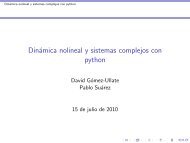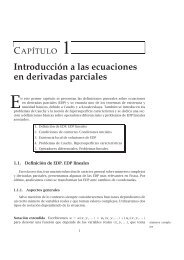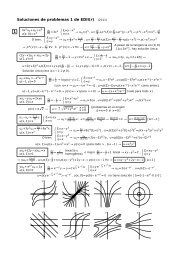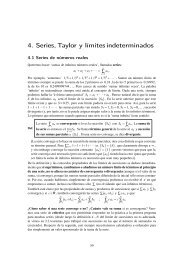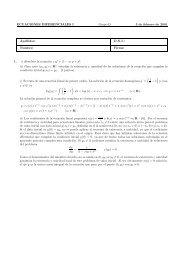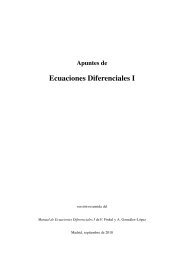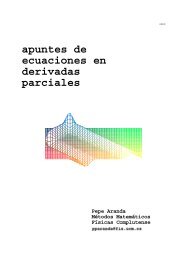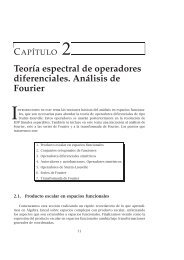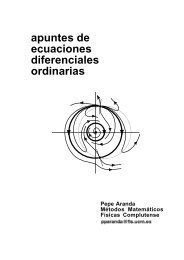68. Continua en R − {−1,0,1} . En x = −1 discontinua ( f(x) → −∞ ).En x = 0,1 continua: lím(x − 1) −x2 +o(x 2 )log|1−xx→0 x= 0 ; lím2 | 2xx→1 x/(x−1)= lím (x − 1) 2 2x(1−x)=x→1 1−x 2 límx→1Es derivable en x = 0 : f ′ (0) = lím(h − 1) log(1−h2 ) −h=h→0 h 2 −lím2 +o(h 2 )= 1 .h→0 h 21+x= 0 .f continua en [0,1] , derivable en (0,1) y f(0) = f(1) ⇒ existe c , 0 < c < 1 , con f ′ (c) = 0 (Rolle).69. f ′ (0) = − 1 2 . lím = ∞ , lím = 0 , f > 0 ∀x y f continua ∀x ⇒ imagen = (0,∞) .x→−∞ x→∞f ′ (x) = xe−x −1+e −xx 2= x+1−exx 2 e x< 0 ∀x ⇒ f decreciente en todo R, pues g(x) = x+1−e x < 0 ∀x(g(0) = 0 , g ′ (x) = 1 − e x po<strong>si</strong>tivo <strong>si</strong> x < 0 y negativo <strong>si</strong> x > 0 ⇒ g negativa <strong>si</strong> x < 0 y <strong>si</strong> x > 0 ).f(x) = 1 − x 2+ ···+(−1)n(n+1)! xn + ··· ⇒ f (n) (0) = n!(−1)n(n+1)!= (−1)n(n+1) . En particular, f (2003) (0) = − 12004 .10
Soluciones a los problemas 70-100 de Cálculo I (2006-2007).70. f continua a trozos. F continua en [0,3] y derivable salvo en x = 2. F(3) = log4.7<strong>1.</strong> F(1) = ∫ 1−1 te−t4 dt = 0 (integrando impar). F ′ (x) = xe −x4 + 2(1−2x)e −(1−2x)4 ⇒ F ′ (1) = −e −1 .Por la regla de la cadena: (F ◦F) ′ (1) = F ′ (F(1))F ′ (1) = F ′ (0)F ′ (1) = (2e −1 )(−e −1 ) = −2e −2 .F(0) = ∫ 01 te−t4 dt = − ∫ 10 te−t4 dt < 0 [integrando po<strong>si</strong>tivo en (0,1) ] ⇒ F(0) < F(1) .72. ∫ 1−1 f(x)dx = [ log|∫ x−1 sen(t3 )dt + x+4| ] 1 −1 = log 5 3 , pues ∫ 1−1 sen(t3 )dt = 0 (integrando impar).73. a) F crece en [0, 1 √3] y decrece en [ 1 √3,2] , F(0) = 0 , F(2) < 0 . Máximo en x = 1 √3; mínimo en x = 2 .b) G crece en [−1,3] y decrece en [3,6] , K(−1) < 0 , K(6) > 0 . Máximo en x = 3 ; mínimo en x = −1 .c) H ′ (x) = 1 − cos(senx) ≥ 0 . Se anula <strong>si</strong> x=π . H creciente en [1,4] ⇒ mínimo en x=1 , máximo en x=4 .74. f ′ (x) = 2xe x4 (1 − 2x 2 ) ⇒ f(x) crece en (−∞,− 1 √2] ∪[0, 1 √2] y decrece en [− 1 √2,0] ∪[ 1 √2,∞). f(0) = −<strong>1.</strong>e t2 crece <strong>si</strong> t > 0 ⇒ f( 1 √2) < ∫ 1/20e 1/4 dt − e 1/4 = − e1/42< 0 (valor máximo). f(x) no se anula en [0,∞).75. f ′ (x) = x(x−1)logx> 0 ⇒ f estrictamente creciente ⇒ f admite inversa, para x ≥ 2.76. f ′ (x) = e 4arctanx ∀x (TFC). Como f(1) = ∫ 11 = 0 , f ′ (1) = e π , la recta tangente es: y = e π (x − 1) .f ′ (x) > 0 ∀x ⇒ f estrictamente creciente en todo R y existe f −1 . ( f −1 ) ′ 1(0) =f ′ ( f −1 (0)) = 1f ′ (1) = e−π .77. F ′ (x) = − 2 x 3 e −1/x8 − 1 x 2 e −1/x4 ⇒ F ′ (1) = − 3 e . ∑(−1)n F(n) es alternada, pues F(n) > 0 (integrandopo<strong>si</strong>tivo y 1 n 2 > − 1 n ), F(n) es decreciente (F′ (x) < 0 <strong>si</strong> x > 0) y F(n) → 0. Por Leibniz, converge.78. H ′ (x) = 8x 2 e −4x2 − x 2 e −x2 = 0 ⇒ x = 0, x = ± √ log2.H crece en [− √ log2, √ log2] y decrece en el resto de R.En x = √ log2 hay un máximo local (y absoluto).El valor máximo de f (en x = ±1 ) es 1/e . El de H :H( √ log2) = ∫ 2 √ log2√ log2t 2 e −t2 dt ≤ ∫ 2 √ log2√ 1log2 e dt = 1 √e log2



